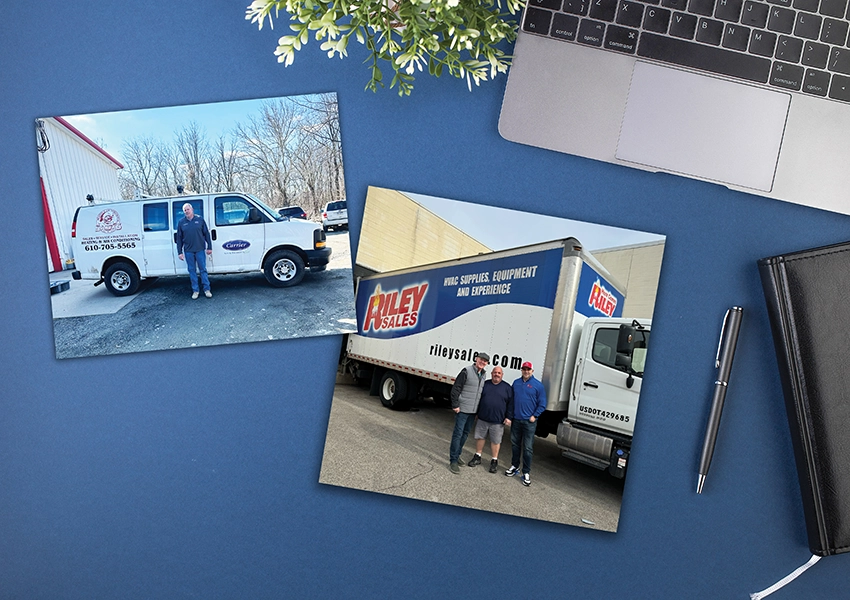To improve customer service, increase safety and save money, get organized!
It’s no wonder your service techs’ vans are a mess: It’s the middle of summer; it’s blazing hot; and they’ve got a backlog of customers whose air conditioners are on the fritz. And as anyone in the hvacr business knows, techs need lots of parts, pieces, and tools in order to properly service customers. Keeping track of everything is no easy task.
“During hectic times, when the temperature is hot or cold, things just get thrown in there,” says Jason Obrzut, director of education at HVAC Technical Institute of Chicago. “I’ve seen vans that can make your stomach turn.”
Concurring with Obrzut is Jim Fuller, president, Inlad Truck & Van, an upfitter with locations in Illinois, Maryland, and Wisconsin. “You wonder sometimes how they can even operate. A lot of times they don’t even know what they’ve got in their truck.”
But you as a company owner or leader can do something. Investing time, training, and resources in a fleetstocking- and-organization program can save money and improve customer service, according to Obrzut, Fuller and others with in-depth knowledge of the industry.
Such a program can:
- Improve efficiency because techs or parts runners are making fewer trips to the supply house.
- Make vehicles safer (no parts flying around loose) and prevent damage to parts, machinery, and tools.
- Keep customers happier because techs don’t have to stop or reschedule a job because a part or tool is missing.
- Help companies adapt to changes in the marketplace — for example the trend toward using smaller trucks and vans to save on fuel consumption, such as the Ford Transit Connect, a popular vehicle in Europe that is now available in the U.S.
Look for a Good Storage System for Starters
The backbone of an organized service vehicle is a storage system that safely holds parts, can incorporate labeling, and can be configured for maximum efficiency depending upon a company’s unique requirements. UK-based company Vanbitz (www. vanbitz.co.uk) says the use of internal van racking and shelving has these major advantages:
- Increasing the carrying capacity of the van, enabling more to be carried.
- Allowing components and tools to be found quicker.
- Helping to prevent damage to tools and components.
- Presenting a more professional image to the customer and onlookers.
Crystal Lake, Ill.-based Knaack LLC, known for its KNAACK® secure jobsite storage, also manufactures and markets a line of WEATHER GUARD® truck and van equipment. This includes van storage solutions introduced earlier this year for the Transit Connect. Some of the features of the storage solutions include a custom bulkhead, space-maximizing design, and a widerange of shelving and accessory options.
The custom bulkhead protects against shifting loads, minimizes rattling, and optimizes space, says Mike Sover, senior product manager for Knaack, a division of Emerson Electric. The shelving units fit tightly to the walls, freeing up floor space, while 12-inch and 14-inch shelf widths provide storage flexibility.
In addition, cabinets, drawer units, and floor storage options can be customized to specific requirements. “These products offer a lifetime warranty and are designed to be rugged and withstand years of vigorous use,” Sover says.
Stress How Organization Helps Technicians
Being organized takes a daily commitment from service technicians. Support them by explaining that their jobs will be much easier if they stick with the routine. A group called the National Association of Professional Organizers, a non-profit educational association whose members include organizing consultants, addresses the issue of organizing this way on their Web site (www.napo.net):
“Organization is a process, not a state achieved in one day. Think about it as being organized or staying organized, not getting organized . . . after that, the challenge is to continuously maintain it and work on it one day at a time. The good news is once you learn good systems, habits, and tools, change becomes easier, as does bouncing back from an unexpected detour or period of feeling overwhelmed.”
In fact, after your technicians experience what it’s like to be organized, they may start offering up even more ideas on how to improve van stocking and organization.
Include Inventory Control
Van organization goes hand-in-hand with inventory control, which is just as beneficial as being organized. (See “A Better Way for Pine State Services,”)
“When it comes to taking inventory, you need to know what supply is low or out,” Obrzut says. “Some companies do it weekly, daily, or everyother- day.” Depending upon individual circumstances, some companies might implement both programs at once. Others might do one first, then the other. If this is the case, start with organization first.
At the End of the Day
Creating and maintaining organized vehicles will most likely take a bit of effort at first, but in the long run that effort will pay off. Techs will spend far less time on search expeditions looking for parts and tools, their vehicles will be safer, and you will spend less money on fuel and replacing broken parts.


